Naming the Paradigms
Origins
Discovery: The approach taken here is based on observation of the social world including the literature of various disciplines, particularly social sciences, and theme-based investigations. From these accounts, it has been possible to deduce the existence of just which underpin .
Naming: As in previous Typologies, I will have to invent names for the methods (paradigms), drawing so far as possible on terms used in the literature—but not necessarily with precisely the same reference.
Literature: The situation for seems wholly unlike and where there is an extensive practical and philosophical literature that argues and explains the diverse methods in great detail. Such studies, guiding beacons for the taxonomic analyses in this website, are lacking in the .![]() More
More
Properties: The object of depiction for change, "what we are dealing with", is typically a situation or, more abstractly, an entity. The characteristic properties of the paradigms presented below have been abstracted from example situations, and may therefore be coloured by their idiosyncratic features. If a mentioned property does not apply to all situations, it may either be an error or it may be a characteristic that variably manifests according to opportunity.
The Depicter: The hypothetical person creating the depiction is called a "depicter", but such a person may not be identifiable in many cases. Sometimes, as explained in the previous topic, the leader is the depicter. At other times, an investigator or consultant is the depicter. But very often the depiction method appears to be part of the situation and assumed by all participants.
Identification
Identifying paradigms is a separate task to sequencing them. Determining the correct taxonomic order of a Principal Typology can be difficult: see more here.
This topic will list the paradigms starting with what seems to be the simplest and moving progressively to what seems to be the most complex. A graphic plus a few characteristic properties are offered for each. Further elaboration and comparisons will follow in subsequent topics. Finally, there will be a summary in the review section.
Unitary Paradigm

A depiction is the first and seemingly absolutely simplest concept of a situation or entity as an undifferentiated whole. See diagram.
The depicter imposes indivisibility as the primary ordering principle.
The paradigm prefers stability and seeks to ensure no change in the entity. If change is imposed, then there is a fight to restore the status quo.
Over time, the situation/entity will either expand or contract as a whole.
Individual entities within the situation/entity are viewed as a part of a mass i.e. inter-changeable and replaceable.
Abridged from the report by Lei![]() on YouTube:
on YouTube:
Since you've decided to pursue a political career, you must take the advice I give below to heart:
1. Do not seek the truth. Do not try to understand the truth of the matter. Let the intellectuals pursue truth, that's their business. What the superiors advocate is simply correct.
2. Learn to tell lies and be good at it. Being an official is most similar to being a prostitute, with the difference being that an official sells his mouth.
3. You should have academic credentials but not true knowledge for true knowledge will destroy you. With knowledge, you would think independently and independent thinking is a big taboo in politics.
4. What is the purpose of being an official? It's for getting benefits. Some call this corruption. It's the only purpose. Once the purpose of seizing benefits becomes vague, failure is not too far away.
5. You must know how to manage relations first before doing the work. Don't misunderstand this as having both integrity and talent. Managing relations means weaving yourself in the network around you. Those who mistake ability as job performance are in for rough days.
6. The way you work must be the same as farmers, focusing on short-term gains, being very short-sighted. Once you took too far ahead, you no longer belong here and the consequences are unimaginable.
7. Believe that flattering is a high art. Flattery is to gain the appreciation of superiors. In a society ruled by centralized power, the appreciation of superiors is the only path to advancement, everything else is a formality.
8. All laws, regulations and policies are not to be strictly followed, to put it precisely, they can all be flexible in practice.
The revolves around power over an undifferentiated entity to avoid change. These rules ensure that ideas/rules/knowledge are malleable, any official is replaceable, and nothing is done to disturb the status quo.
Dualistic Paradigm
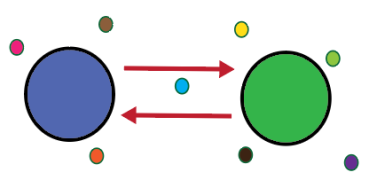
The depiction of a situation or entity is as a duality in the midst of variety. See diagram.
The depicter assumes dichotomization with opposition, argument or conflict between two main components.
So expectation of polarization is the primary ordering principle.
Over time, the situation/entity will tend towards an equilibrium.
The paradigm expects the situation/entity to be maintained in support of the two main components while undergoing slow evolution. If change is imposed, then each component will press for a better outcome for itself.
Individuals within the situation identify with the interests of one or other component.
Causal Paradigm
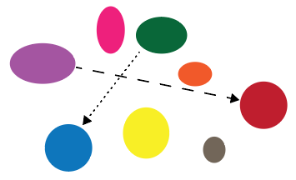
The depiction sees the situation or entity as consisting of a multiplicity of elements or factors with some distinct causal connections. See diagram.
The depicter expects and requires causally-connected factors to be identified and reliably function in a particular way. So predictability is the primary ordering principle.
Over time and with scrutiny or experiment, the situation/entity appears to become ever more complex.
The paradigm expects that there will be partial and controllable improvements to the functioning of the situation/entity based on developing a proper understanding and using prediction. If change is imposed, then it is necessary to check there is genuine benefit in key factors.
Individuals/components are viewed as potentially effective agents that may affect or manipulate others in the system.
Structural Paradigm
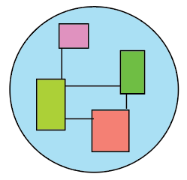
The depiction assumes that the situation or entity is bounded, internally structured and with ordered specified relationships. See diagram.
The depicter expects to be able to determine an order for the components—and that is the primary ordering principle.
This order enables flows and is often partially or wholly hierarchical. Components must be well-defined to allow their explicit organisation.
Over time, the situation/entity actively maintains its order, controlling components as required to ensure relevant requirements like efficiency, strength and security. That order determines a socially recognizable identity.
The paradigm expects that entity change may occur in the form of a re-organisation. If change is imposed, then order will be maintained by re-structuring as appropriate.
Individuals (or components) are viewed as filling a role needed by the situation/entity or as a member of a class or category.
Dynamic Paradigm
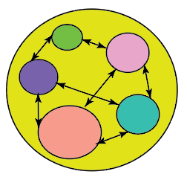
The depiction assumes that the situation or entity is a system consisting of components (not themselves systems) in a dynamic relationship. See diagram.
The depicter assumes there is interaction between the components of the situation/entity. So recognizing feedback is the primary ordering principle.
Over time the entity is expected to grow.
The paradigm assumes that entity change will occur in the form of directed evolution and increased symbiosis of the components. If change is imposed, the system flexibly reacts and adapts.
Individuals/components are viewed as members of a set or group or (if people) a community, ready and able to give feedback on matters that affect them.
Atomistic Paradigm
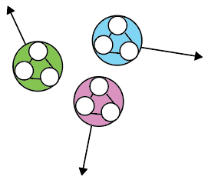
The depiction assumes that the situation or entity consists of a discrete independent elements each of which is a compound dynamic system or individual surrounded by other similar entities. See diagram.
The depicter regards respect for boundaries as the primary ordering principle.
Over time, the various self-sustaining bounded systems/individuals will learn to co-exist, cooperate and create networks.
The paradigm expects that change will occur in an unpredictable way through independent self-motivated re-positioning. If change is imposed, then each system will check for implications and look for opportunities to get protected and gain advantage.
Entities are individuals viewed as autonomous and responsible.
Unified Paradigm
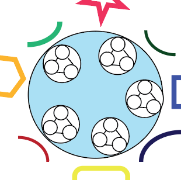
The depiction assumes that the situation or entity is a dynamic system of dynamic systems interacting dynamically with its environment. See diagram.
The depicter assumes that co-evolution of all systems including the environment is occurring, and that is the primary ordering principle..
Over time, there is positive evolution and increased cohesion.
The paradigm expects that change is a continuous process of organic growth and co-evolution with the changing environment. If change is imposed, then there is an acceptance and a willingness to "go with the flow".
Individuals are unique and irreplaceable.
Studies using this paradigm are inherently transdisciplinary.
Review
The pattern of increasing complexity is easy to observe:
We start with a paradigm that is a simple undivided unstructured unity: called .
Then a paradigm that is an unstructured duality of unities: called .
Then a paradigm that is an unstructured multiplicity of unities: called .
Then a paradigm that is a compound structured entity whose components are identifiable and linked: called .
Then a paradigm that is a compound structured entity whose identified components interact: called .
Then a paradigm that is a multiplicity of discrete entities with internal structures and dynamics: called .
Finally a paradigm of a compound structured entity containing compound entities and being part of its environment: called .
In describing these paradigms, it may seem that the paradigm is describing a person but, by definition, this is not the case. It is true that there will be individuals who will see themselves and others through an lens, but these are typically libertarians.
Taking the larger view, a person can also be depicted by using other paradigms:
- through a lens, a person is blind to their own inner workings, expects others to bend to his will, and tries to encroach on their space.
- through a lens, a person sees themselves as defined by a conflict: e.g. between good and evil, between family life and personal career.
- through a lens, a person sees themselves as making things happen and being forced to act in a certain way.
- through a lens, a person functions using a framework of ideas (like a religion, or this Taxonomy).
- through a lens, a person is a manifestation of a psyche in which temperament, drives, needs, habits and similar all interact.
- through a lens, every person is a unique cosmic miracle playing their necessary part in the evolution of humanity.
Process
An approach emphasizing that reality is in constant change. However, this appears to be a version of either or . If the focus is on flows, then possibly is implied.
Narrative
This belongs to communication, emphasizing the importance of interpretation, meaning and values to describe a situation. It was identified, for example, as a feature in affecting and shaping societal institutions. However, any particular narrative will be determined by one of the .
Mystery : Unknowability
This is to retreat from having any account or model, and so it cannot be used to handle change.
In Review section: see an analysis of the relation between depiction and forms of reality.
The above sequencing seems "natural": but is it taxonomic within THEE?
- Check other examples where natural and taxonomic sequences differ.
- Then determine the Typology Essentials Table layout to discover the taxonomic order within THEE.
Originally posted: 30-Jun-2024.
